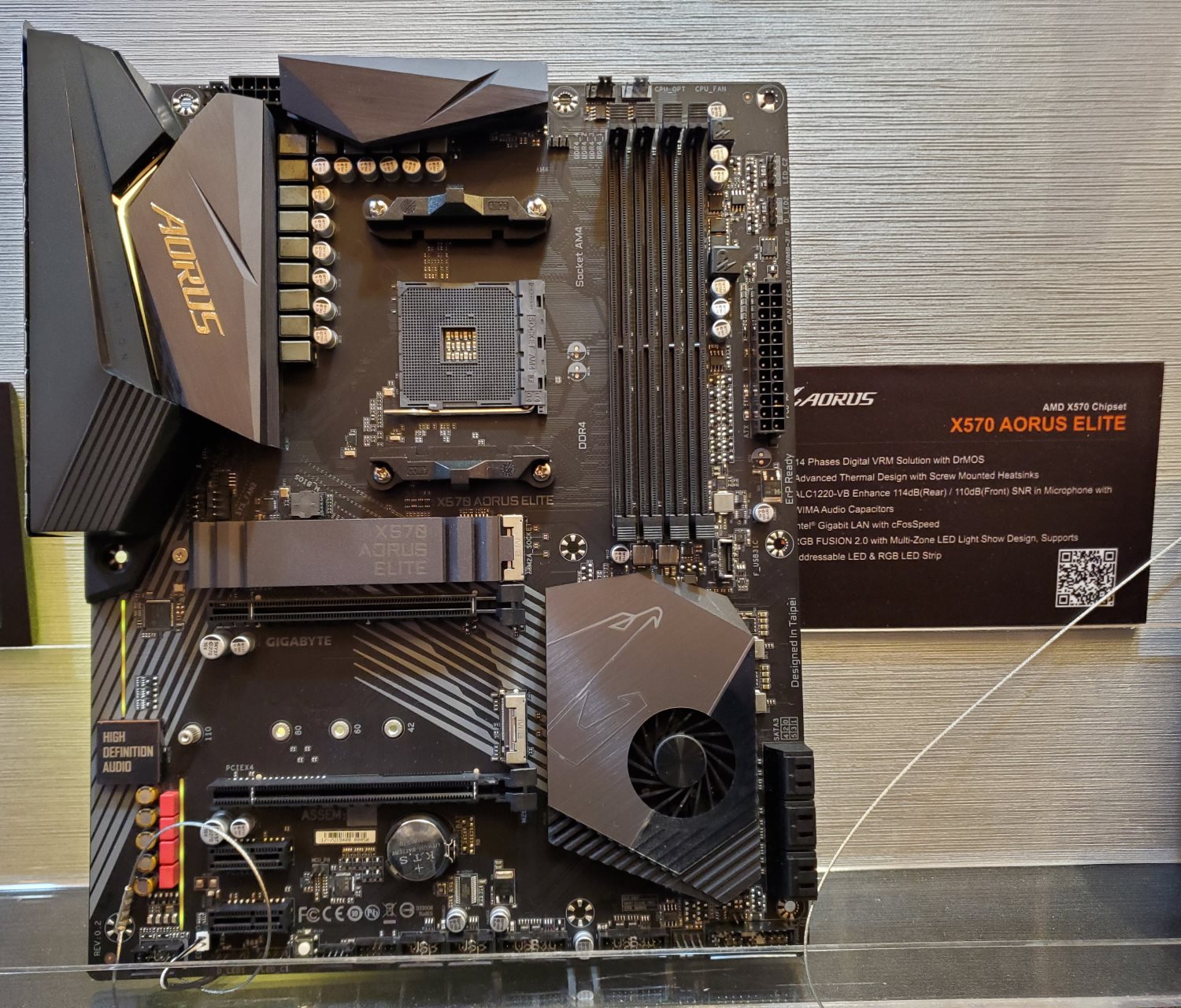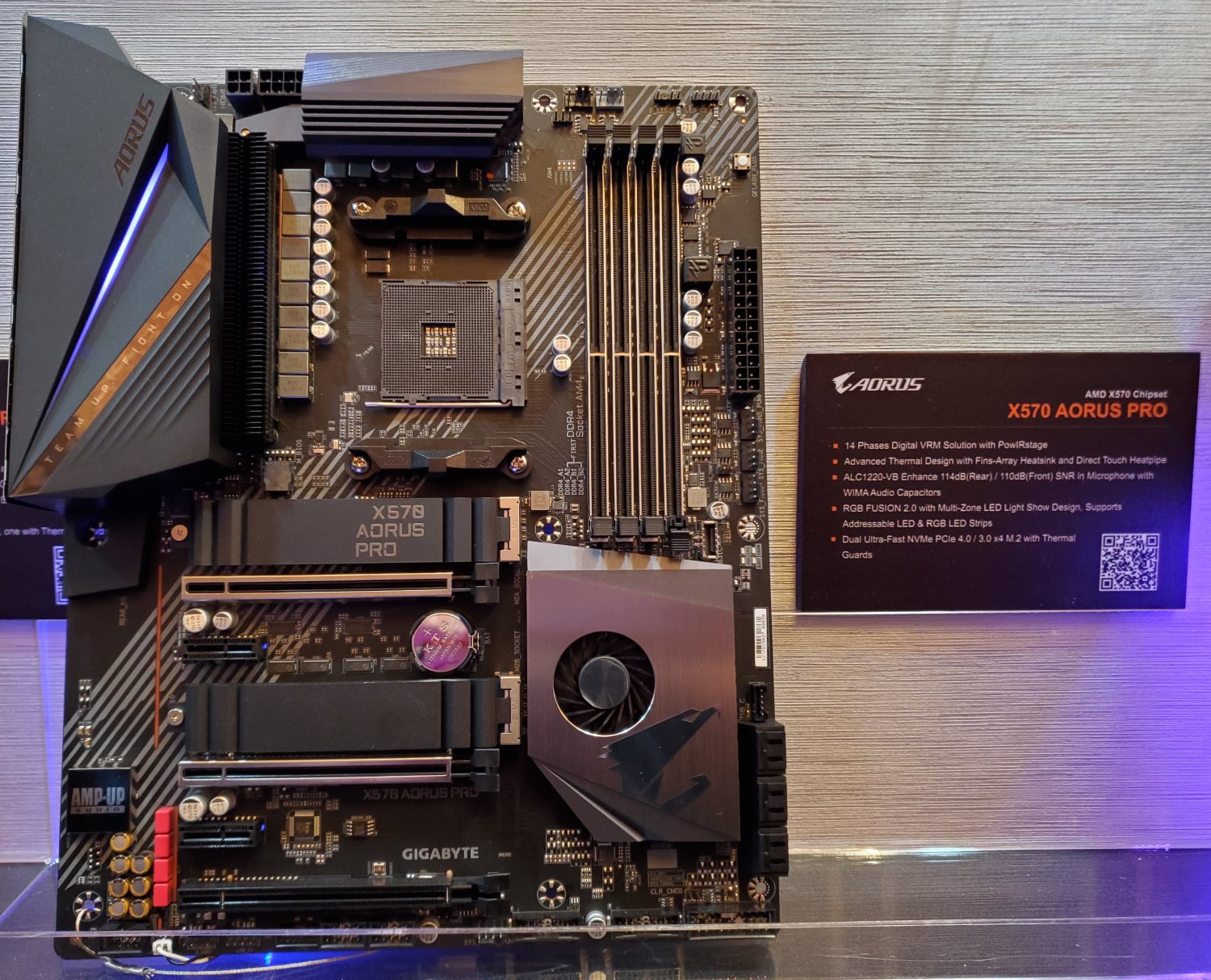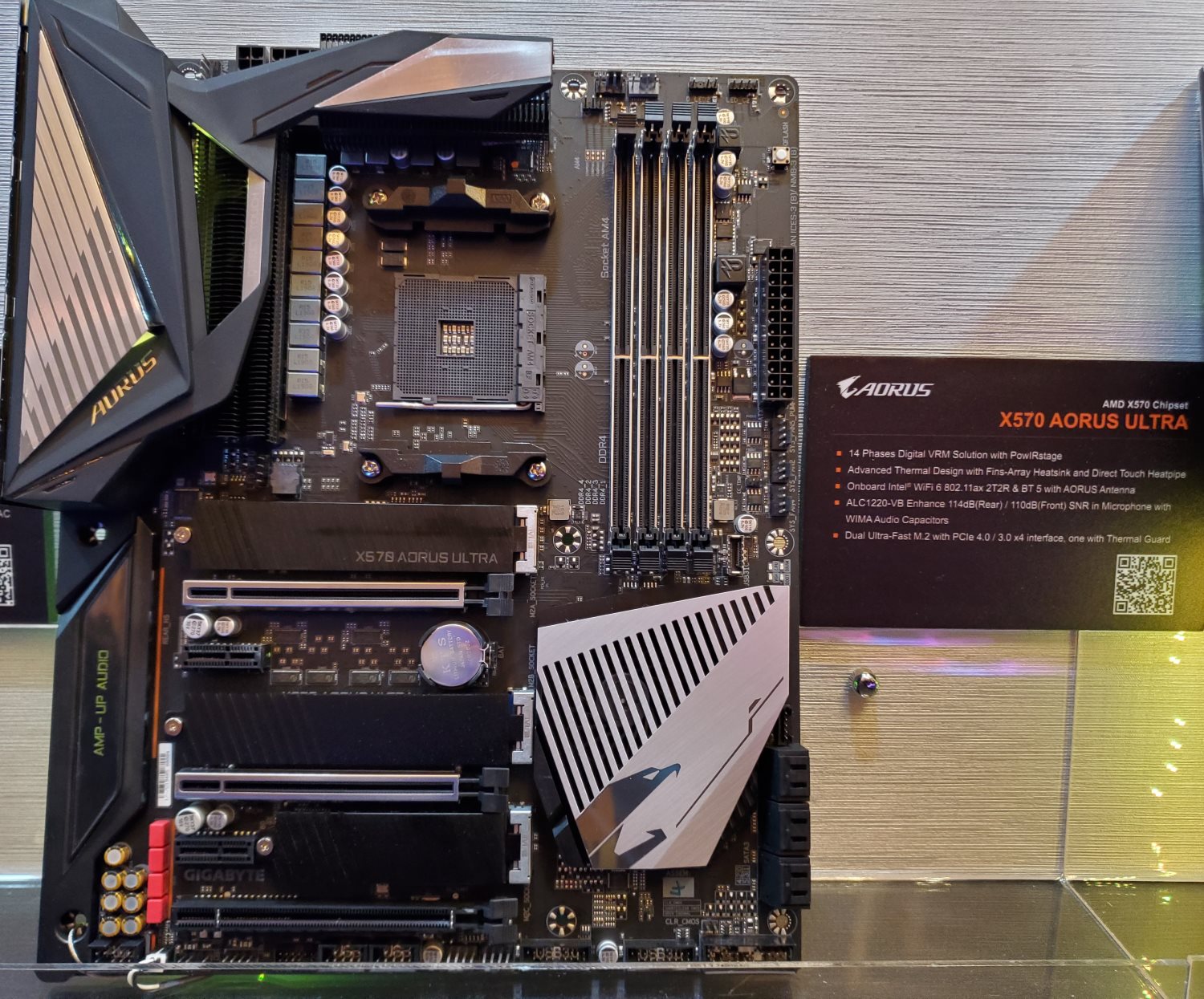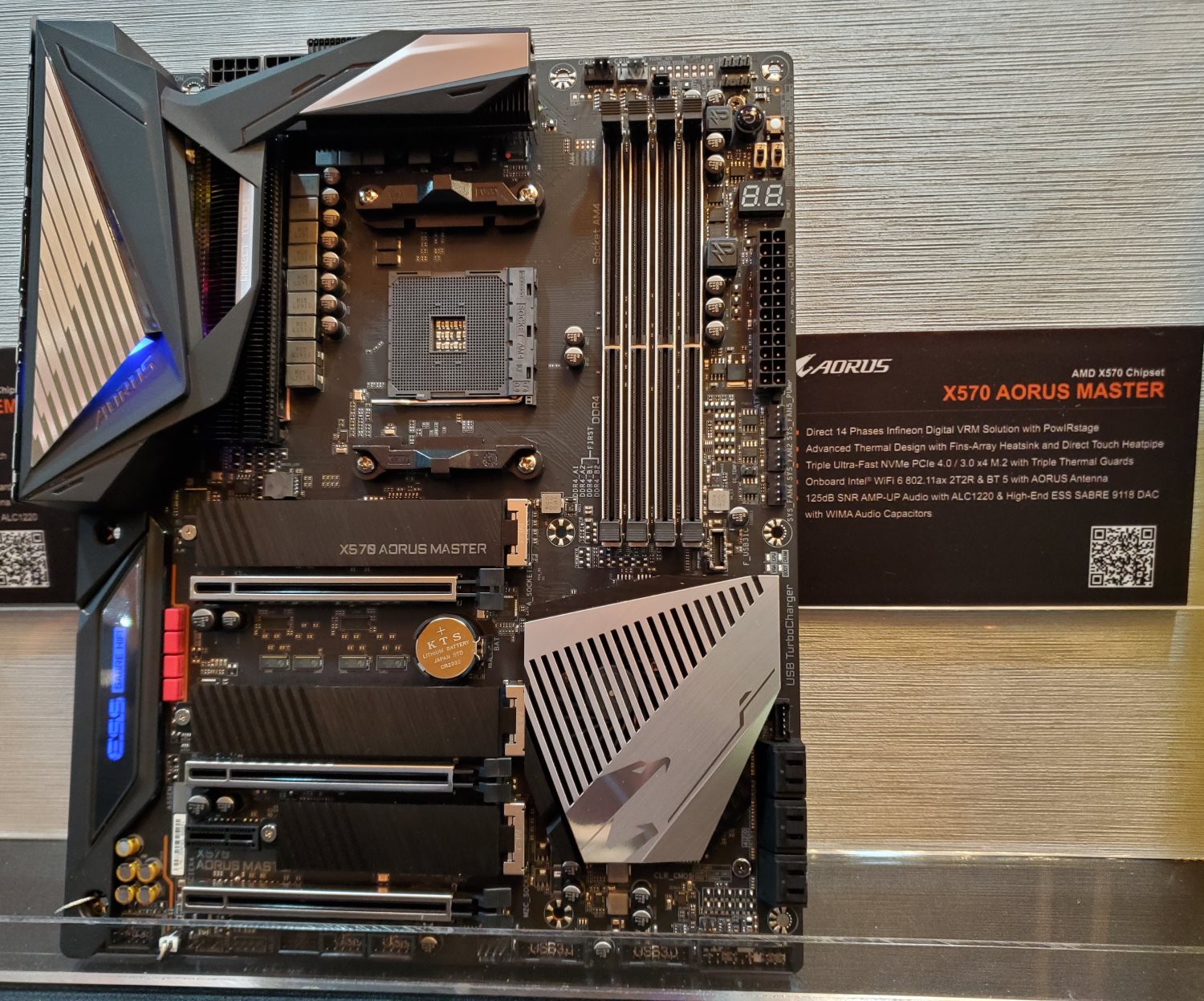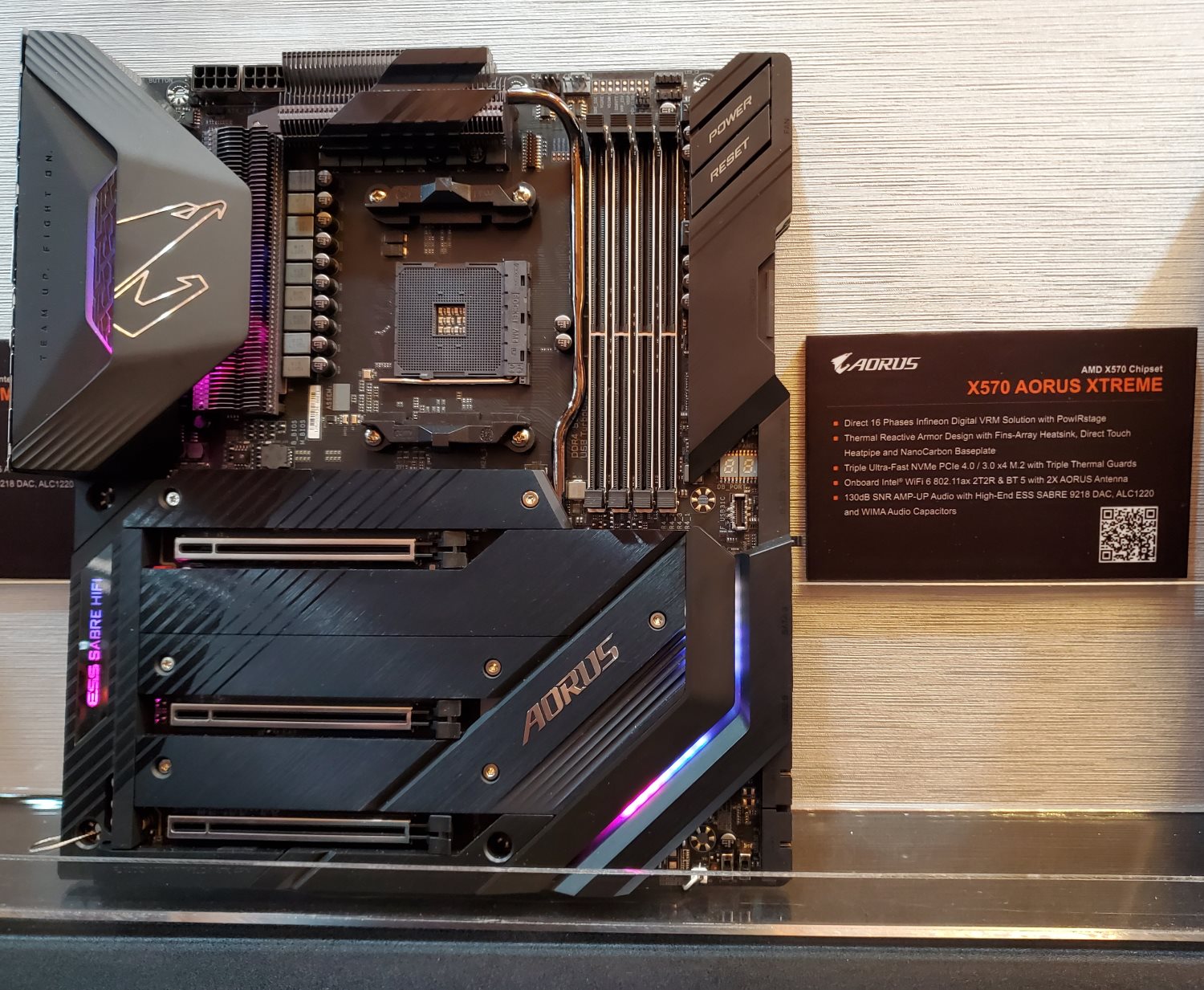Gigabyte Shows Off Six Aorus X570 Boards for Ryzen 3000 CPUs
Gigabyte's Computex showcase this year included an updated Aero laptop with an OLED panel, as well as a fast PCIe 4.0 SSD. But the company's six new Aorus-branded X570-based motherboards designed for AMD’s Zen 2/Ryzen 3000 based processors also caught our interest. In talking with the Gigabyte representatives, there will be more boards fleshing out the complete lineup as time goes on, including Gigabyte-branded boards. But for now, we have a significant part of the Aorus Gaming lineup, which includes the X570 Aorus Pro, Pro I Wi-Fi, Elite, Ultra, Master, and Xtreme which covers a wide range, from mid-range to flagship.
Below we have a few details from the specifications page of the boards, but pricing and availability details were not listed or shared directly from Gigabyte. In parenthesis, we have added the price brackets we heard these will be around when the do release, but are subject to change. Some takeaways from the current lineup are improved VRMs for the new CPUs, fans on the chipset heatsinks for cooling (in all but one case), and memory speeds being rated to just 3200 MHz (we’ve seen other boards list support for DDR4 4400 MHz for example). RGB LEDs are fewer and more tastefully implemented than we have seen with past Gigabyte boards, an overall improvement on aesthetics in our opinion.
Below are details from each of the boards we saw.
X570 I Aorus Pro Wi-Fi (~$219)
The first board is an ITX-sized offering in the X570 I Aorus Pro Wi-Fi. The diminutive board sports an 8-phase Digital VRM, along with a large heatsink for cooling the power bits. The chipset heatsink is located just above the reinforced PCIe slot and uses a small fan to keep it cool.
The Pro Wi-Fi includes on-board Intel Wi-Fi 6 (802.11ax) wireless with Bluetooth 5 support, along with a wired Intel GbE LAN chip. Integrated audio is sourced from a Realtek ALC1220-VB codec with Nichicon Audio capacitors and supports up to 7.1 channel audio.
USB connectivity on the back panels totals six ports. There are four USB 3.1 Gen 1 ports and a USB Type-C and Type-A ports (one each) supporting USB 3.1 Gen 2 connectivity.
Get Tom's Hardware's best news and in-depth reviews, straight to your inbox.
On the storage front, the Aorus Pro Wi-Fi includes two M.2 slots. When using a Third Gen Ryzen processor, both slots run at PCIe 4.0 x4/x2 speeds. For SATA-based drives we can see six SATA ports which support RAID0, 1, and 10. USB connectivity includes a USB 3.1 Gen 2 (10 Gbps) port out back plus an internal header. An additional USB 3.1 Gen 2 Type-A port is also found on the rear IO along with four USB 2.0 ports.
Memory capacity is listed to 64GB through its two reinforced slots, while memory speed support is listed up to DDR4 3200 MHz when using Third Gen AMD Ryzen processors, while Second Gen is limited to 2933.
X570 Aorus Elite (~$199)
The X570 Aorus Elite is an ATX board and at this time appears to be the entry level X570 Aorus board in the lineup. The Elite rocks a 14-phase digital VRM with dual heatsinks tasked with keeping them cool, along with RGB lighting integrated in the shroud. The chipset includes the Aorus eagle along with a small fan to keep it cool.
Network connectivity is handled solely by a wired Intel GbE LAN chip (no included Wi-Fi). Audio on this board is managed by the Realtek ALC1200 codec and supports up to 5.1 channels. We can also spy more Nichicon and WIMA audio caps (in red) as well.
Storage on the X570 Aorus Elite includes six SATA ports along with two M.2 slots. Both M.2 slots support SATA drives or PCIe 4.0 x4/x2 drives when using a 3rd gen Ryzen CPU. The top slot does include a heatsink to keep the warm-running NVMe drives running cool.
USB connectivity includes two 3.1 Gen 2 (10 Gbps) Type-A ports out back and another (though Type-C) through an internal header. Four additional USB 2.0 ports are also located on the rear IO for a total of six ports out back.
The Elite contains two full-length PCIe slots as well as two x1 size slots. The top slot supports PCIe 4.0 x16 from the CPU with 3rd gen Ryzen processors while the second slot runs at PCIe 4.0 x4. AMD Quad-GPU Crossfire and 2-Way AMD Crossfire technologies are supported.
The four non-reinforced DIMM slots support up to 128GB of DDR4 memory with speeds listed to DDR4 3200 MHz for Tird Gen CPUs and 2933 MHz for Second Gen Ryzen CPUs.
X570 Aorus Pro (~$249)
The Aorus Pro is next in line up the product stack and also uses a 14-phase digital VRM with dual heatsinks. The difference here between the Elite and Pro are different heatsinks and improved styling along with the addition of a 4-pin EPS 12V to the existing 8-pin EPS. RGB lighting is tastefully implemented with only a small line on top of the IO shroud. The chipset heatsink is similar to the Elite with the Aorus eagle on it and a small fan for cooling.
Like the Elite, the Pro has a single Intel GbE LAN chip for networking duties. Audio functionality here is handled by a Realtek ALC1220-VB codec and up to 7.1 channel audio. We can also spot more Nichicon and WIMA audio caps here too.
USB support on the rear IO consists of three USB 3.1 Gen 1 ports as well as a USB 3.1 Gen 2 (Type-A). A USB 3.1 Gen 2 Type-C port can also be found on the back panel. In addition to all of the USB 3.x support four USB 2.0 ports can be found out back totaling 10 ports available.
Storage on this mid-range X570 board comes in the form of six SATA ports again support RAID 0, 1, and 10. The two M.2 slots run at PCIe 4.0 x4/x2 as well as SATA modules. Both M.2 slots on the board use heatsinks (Thermal Gaurds) to keep the drives below them cool.
The Pro uses three full-length PCIe slots as well as two x1 size slots. The primary GPU slots use reinforcement with the top slot supporting PCIe 4.0 x16 from the CPU and the second slot PCIe 4.0 x8 (Third Gen Ryzen only). Up to AMD Quad-GPU Crossfire is supported along with NVIDIA Quad-GPU SLI and 2-Way NVIDIA SLI.
Memory capacity on the Aorus Pro’s four DIMM slots is up to 128GB with speeds rated to 3200 MHz with a Third Gen Ryzen processor. The DIMM slots are also reinforced.
X570 Aorus Ultra (~$299)
The Aorus Ultra starts to move into the high-end with more ornate features such as the shroud covering the IO area, three M.2 slots, all with heatsinks, as well as a different design on the chipset heatsink which hides a fan underneath. The board uses a 14-phase digital VRM along with large finned heatsinks on both sets of power bits.
The Ultra includes an Intel GbE LAN chip for wired networking as well as Intel Wi-Fi 6 802.11ax adapter with Bluetooth 5.0. Speeds can reach up to 2.4 Gbps. Audio duties are handled by the now familiar ALC1220-VB codec which supports 7.1 channel audio and includes an S/PDIF out in back. Again, we see more Nichicon and WIMA audio caps.
Storage on the SATA front consists of six SATA ports which support RAID 0, 1, and 10. The Ultra steps up to three M.2 slots (2x 22110, one 2280). All drives support PCIe 3.0 x4/x2 as well as SATA modules. All three slots use heatsinks for the M.2 modules.
USB connectivity is the same as the Pro with three USB 3.1 Gen 1 ports as well as a USB 3.1 Gen 2 (Type-A). A USB 3.1 Gen 2 Type-C port can also be found on the back panel. In addition to all of the USB 3.x support four USB 2.0 ports can be found out back totaling 10 ports available.
When talking PCIe slots, the Aorus Ultra brings two full-length and reinforced slots with a 3rd full-length slot which does not have the reinforcement. The top two slots run at PCIe 4.0 x16 and x8 respectively using 3rd gen Ryzen CPUs while the last slot is fed from the chipset and runs at x4 speeds. In addition to the full-length slots are two x1 slots.
The four DIMM slots on the Ultra are also reinforced with speeds listed up to DDR4 3200 MHz with capacity up to 128GB.
X570 Aorus Master (~$349)
The X570 Aorus Master looks almost exactly the same and functions the same as the Ultra with a few caveats including 2.5 GbE networking and a different audio codec. It still uses the same 14-phase digital VRM and heatsink setup (though it has two 8-pin EPS connectors feeding them power) along with the same minimal RGB lighting on the shroud above the VRMs and by the audio area. Other obvious changes on the board include more fan headers, switches, and debug LEDs. There is also voltage read points located above the DRAM slots so you know you are getting into the higher end when we see these on board!
Networking capabilities is one area where the Master sets itself above the rest so far. Hardwired is an Intel GbE LAN chip we’ve seen on the lower boards, but new is a Realtek 2.5 Mbit LAN chip for ultra-fast transfer capabilities.
The Aorus Master uses the same 7.1 channel Realtek ALC1220-VB codec but adds an ESS Sabre9118 DAC chip versus the Ultra which forgoes such an addition. Nichicon and WIMA audio caps are also found here.
Storage on the Aorus Master comes in the form of six SATA ports supporting RAID 0, 1, and 10 along with three M.2 slots. All three M.2 slots are are PCIe 4.0 x4/x2 and will handle SATA modules as well.
On the USB side of things there are a total of 10 ports on the back panel. Three USB 3.1 Gen 2 Type-A ports and a Type-C support Gen 2 for 10 Gbps connectivity, two USB 3.1 Gen 1 ports, along with four USB 2.0 ports round out all the other ports on the rear IO.
The Master has three full-length reinforced PCIe slots along with a single x1 slot. The primary GPU slot (top) runs at PCIe 4.0 x16 while the second slot runs at PCIe 4.0 x8. The third slot is connected via the chipset and run at PCIe 3.0 x4 when using a Third Gen Ryzen CPU. Multi-GPU support comes in the form of NVIDIA Quad-GPU SLI and 2-Way SLI with Quad-GPU Crossfire and 2-Way Crossfire support for AMD based video cards.
The four reinforced DIMM slots support up to 128GB of RAM with speeds up to 3200 MHz.
X570 Aorus Xtreme (~$599)
Gigabyte’s flagship X570 motherboard is the Aorus Xtreme. The Xtreme takes things to a different level with uniquely styled shrouds found covering most of the board giving it a very clean and premium appearance. The Xtreme uses a 16-phase digital VRM along with finned heatsinks covering both sets of VRMs. A heat pipe connects the two heatsinks together along with another heat pipe connecting to a fan less chipset heatsink (the first we've seen on X570).
We can see high end features such as voltage read points and temperature headers giving it a premium feel. RGBs are found on the rear shroud, on the audio cover, as well as another bar added around the chipset heatsink. Overall, this is a great-looking board and again Gigabyte thankfully didn’t go all out on the RGB lighting here either.
The network implementation is another step up from the Master with an Intel GbE LAN chip, and a 10 Mbit Aquantia LAN chip for wired connectivity. The same Wi-Fi 6 (802.11ax) module is used for the Wi-Fi. The Wireless networking supports up to 2.4 Gbps transfer rates and Bluetooth 5.0.
The Xtreme also uses the premium 7.1 channel Realtek ALC1220 -VB codec along with an ESS Sabre9118 DAC chip and includes Nichicon and WIMA audio caps. The audio stack on the rear IO is a 5-plug analog and S/PDIF out for digital.
The USB ports out back are the same as on the Master with 10 ports in total. Three USB 3.1 Gen 2 Type-A ports and a Type-C support Gen 2 for 10 Gbps connectivity, two USB 3.1 Gen 1 ports, along with four USB 2.0 ports round out all the other ports on the rear IO.
The Xtreme, like the master has three full-length reinforced PCIe slots, however the Xtreme drops the x1 slot. The primary GPU slot (top) runs at PCIe 4.0 x16 while the second slot runs at PCIe 4.0 x8. The third slot is connected via the chipset and run at PCIe 3.0 x4 when using a Third Gen Ryzen CPU. Multi-GPU support comes in the form of NVIDIA Quad-GPU SLI and 2-Way SLI with Quad-GPU Crossfire and 2-Way Crossfire support for AMD based video cards.
The Xtreme’s four DIMM slots support 128GB capacity with speeds again topping out at 3200 MHz.
Overall, Gigabyte has seemingly toned down the styling on their boards and that is a good thing. Their past generations have turned off some users, yet excited others. It just depends on what crowd you are from. Do you like a lot of RGBs or not? There are also a couple of motherboards we didn't see at Computex but expect to see in their lineup soon. An X570 Gaming X (potential entry level board around $170), and the X570 Aorus Pro Wi-Fi, essentially a Wi-Fi enabled version the Pro above.
Pricing or availability on these boards hasn't been pinned down, but we did reach out and ask for details. We will update the article accordingly when the information comes in.

Joe Shields is a staff writer at Tom’s Hardware. He reviews motherboards and PC components.

